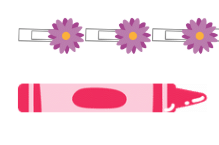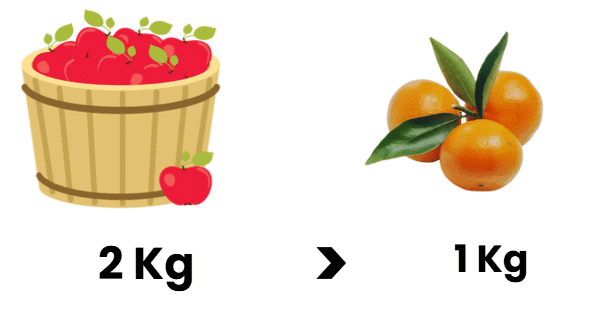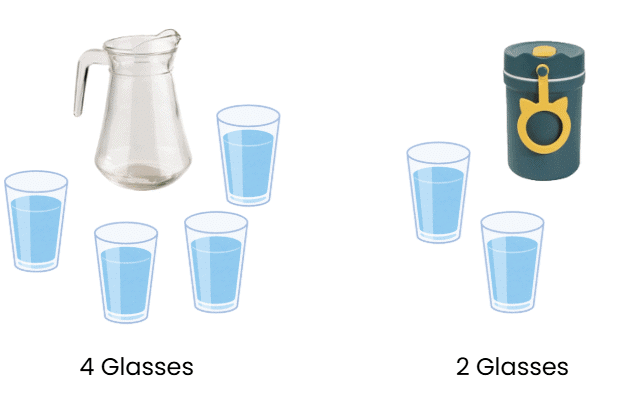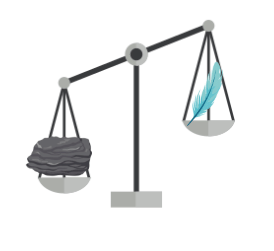Everyday Mathematics: Length, Weight and Capacity | Math Olympiad for Class 2 PDF Download
Q1. A pencil is 5 clips long, and a crayon is 3 clips long. Which object is longer?
(a) Pencil
(b) Crayon
(c) Both are the same
(d) Cannot tell
Ans: (a) Pencil
Therefore, pencil is longer than crayon.
Q2. A boy is 4 hand spans tall, and his sister is 3 hand spans tall. Who is taller?
(a) Boy
(b) Sister
(c) Both are the same
(d) Cannot tell
Ans: (a) Boy
The boy’s height is 4 hand spans, and the sister’s height is 3 hand spans. Since 4 is greater than 3, the boy is taller.
Q3. A bag of apples weighs 2 kilograms, and a bag of oranges weighs 1 kilogram. Which bag is heavier?
(a) Bag of apples
(b) Bag of oranges
(c) Both weigh the same
(d) Cannot tell
Ans: (a) Bag of apples
Since 2 kilograms is more than 1 kilogram, the bag of apples is heavier.
Q4. A ruler is 10 centimeters long, and a pen is 8 centimeters long. Which is shorter?
(a) Ruler
(b) Pen
(c) Both are the same
(d) Cannot tell
Ans: (b) Pen
The ruler is 10 centimeters long, and the pen is 8 centimeters long.
Since 8 is less than 10, the pen is shorter.
Q5. A water bottle can hold 2 glasses of water, and a jug can hold 4 glasses of water. Which has more capacity?
(a) Water bottle
(b) Jug
(c) Both hold the same
(d) Cannot tell
Ans: (b) Jug
The water bottle holds 2 glasses, and the jug holds 4 glasses. Since 4 is more than 2, the jug has more capacity.
Q6. A toy car is 6 centimeters long, and a toy bus is 9 centimeters long. How much longer is the toy bus than the toy car?
(a) 2 centimeters
(b) 3 centimeters
(c) 4 centimeters
(d) 5 centimeters
Ans: (b) 3 centimeters
The toy bus is 9 centimeters long, and the toy car is 6 centimeters long. Subtract 6 from 9: 9 - 6 = 3 centimeters. So, the toy bus is 3 centimeters longer.
Q7. A feather weighs 5 grams, and a stone weighs 50 grams. Which is lighter?
(a) Feather
(b) Stone
(c) Both weigh the same
(d) Cannot tell
Ans: (a) Feather
The feather weighs 5 grams, and the stone weighs 50 grams. Since 5 grams is less than 50 grams, the feather is lighter.
Q8. A bucket can hold 5 cups of water, and a bowl can hold 2 cups of water. How many more cups can the bucket hold than the bowl?
(a) 2 cups
(b) 3 cups
(c) 4 cups
(d) 5 cups
Ans: (b) 3 cups
The bucket holds 5 cups, and the bowl holds 2 cups.
Subtract 2 from 5: 5 - 2 = 3 cups.
So, the bucket can hold 3 more cups than the bowl.
Q9. A table is 1 meter long, and a chair is 50 centimeters long. Which is longer?
(a) Table
(b) Chair
(c) Both are the same
(d) Cannot tell
Ans: (a) Table
The table is 1 meter long, which is 100 centimeters (since 1 meter = 100 centimeters).
The chair is 50 centimeters long.
Since 100 centimeters is more than 50 centimeters, the table is longer.
Q10. A book weighs 200 grams, and a notebook weighs 100 grams. How much heavier is the book than the notebook?
(a) 50 grams
(b) 100 grams
(c) 150 grams
(d) 200 grams
Ans: (b) 100 grams
The book weighs 200 grams, and the notebook weighs 100 grams.
Subtract 100 from 200: 200 - 100 = 100 grams.
So, the book is 100 grams heavier.
|
32 videos|79 docs|77 tests
|
FAQs on Everyday Mathematics: Length, Weight and Capacity - Math Olympiad for Class 2
| 1. What are the basic units of measurement for length, weight, and capacity? |  |
| 2. How do you convert between different units of length, weight, and capacity? |  |
| 3. Why is it important to understand measurements in everyday life? |  |
| 4. What tools can be used to measure length, weight, and capacity accurately? |  |
| 5. How do different cultures use measurement units for length, weight, and capacity? |  |


























